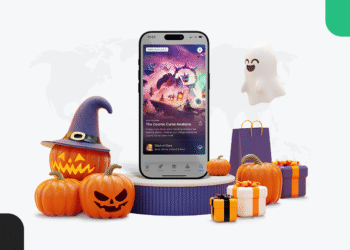Reading Time: 8 minutes
What’s a legacy customer engagement tool?
When you think of legacy customer engagement tools, stand-alone CRMs, email marketing software, marketing automation tools, and analytics dashboards come to mind. These tools need their database in a schema that is compatible with that particular tool.
Does it work in isolation? Yes.
However, the State of Martech 2025 report claims that the average martech stack owned by enterprises has 90-120 tools. Also, marketers are analyzing more data points and attributes than ever before to provide a personalized customer experience.
To tackle the problems that could arise with disjointed tools and data, marketers have been seeking integrated martech stacks that reduce the number of data silos and tools in the stack.
So, to keep up with the changing tides, legacy platforms like Salesforce and Adobe went on an acquisition spree to expand their product portfolios. This included email marketing tools, cloud infrastructures, data analytics, and business intelligence tools.
At the end of the day, these tools were still separate tools with separate databases and their own schema, now owned by these legacy brands. 
Consumer brands that purchased these legacy stacks were:
 Still struggling to optimize customer experiences
Still struggling to optimize customer experiences Still dealing with disparate data that was practically incoherent
Still dealing with disparate data that was practically incoherent Still paying what they were paying (or even more) for all these tools individually
Still paying what they were paying (or even more) for all these tools individually
Legacy Customer Engagement Tools: The Good, The Bad, and The Sus
The Good and the Bad
While the tools acquired by the legacy platforms were individually good at their specialized functions (eg, email marketing, analytics, etc), when they came together, the outcome was far from synergistic.
New problems that came up included:
 Data silos
Data silos Inconsistent customer view across tools
Inconsistent customer view across tools Limited personalization due to fragmentation in customer data
Limited personalization due to fragmentation in customer data Inefficient workflows resulting in manual data cleaning and transfers
Inefficient workflows resulting in manual data cleaning and transfers Difficulty in real-time analytics
Difficulty in real-time analytics Inability to scale as customer data volume and complexity keep growing
Inability to scale as customer data volume and complexity keep growing Fragmentation in the customer journey, resulting in disjointed experiences for the customer
Fragmentation in the customer journey, resulting in disjointed experiences for the customer Integration challenges while attempting to combine individual legacy tools
Integration challenges while attempting to combine individual legacy tools Mediocre results from AI tools since data is fragmented and silos
Mediocre results from AI tools since data is fragmented and silos

The Sus
With legacy stacks, the initial investment is just the beginning. Some observations we have seen from talking to 100s of customers globally who have migrated from these legacy stacks include:
- Implementation and onboarding costs: Can vary from a few thousand to over $100,000 based on complexity, need for custom add-ons, and skilled implementation partners.
- Implementation timeline: The average time observed in the partial implementation of an enterprise customer engagement stack ranges from 6-12 months. This is the average duration taken for the platforms to just go live, and is not the complete duration.
- Hidden costs: These legacy tools often require their customers to mandatorily upgrade (paid) to the latest version of different tools in the martech stack, which essentially is a sneaky way for an ecosystem lock-in.

Impact on TCO?Legacy customer engagement platforms are notorious for giving vague and overoptimistic timelines for implementation and, future upgrade fees, and potential price hikes. Moreover, since their pricing model is based on ‘data credits,’ the chances of burning through these credits in the scenario of attempting real-time engagement are high. In essence, consumer brands that choose legacy customer engagement platforms end up paying much more with time, resources, and missed opportunities for real-time engagement. |
Deconstructing the Power of a Customer Data and Engagement Platform (CDEP)
Instead of having multiple mutually incompatible tools forcefully fit together, what if marketers and product owners had a single streamlined solution?
A single platform where your customer data foundation and your engagement channels are designed to work together from the start.
That’s your Customer Data and Engagement Platform (CDEP).
CDEP vs Legacy Customer Engagement Stacks: A Comparison
A Customer Data and Engagement Platform (CDEP) like MoEngage presents a significant and intentional evolution from legacy customer engagement tools by offering a more unified, flexible solution that offers consumer brands higher ROI at a lower TCO.
Unified Core Data Management Capability and Omnichannel Orchestration
Legacy systems often require separate, disjointed tools for different functions, leading to data silos and inconsistent customer experiences. A CDEP, on the other hand, provides an all-in-one platform.
Inbuilt Capabilities: Unlike legacy stacks that necessitate separate purchases for marketing suites, journey optimizers, personalization engines, analytics platforms, and loyalty management software, a CDEP has these features built in. This includes omnichannel orchestration across email, push notifications, SMS, in-app messaging, and web.
Data Ingestion and Unification: While legacy tools have limited data source support, a CDEP can ingest data from a wide variety of sources, including web/app SDKs, APIs, offline data, and data warehouses. It allows for the creation of custom objects and attributes, enabling more sophisticated data modeling and segmentation directly from a data warehouse.

Data Democratization and a Vendor-Neutral Ecosystem
A primary drawback of legacy tools is their ‘locked-in’ ecosystem, which restricts integration with outside platforms. CDEPs are designed for flexibility and interoperability.
Open Integration: CDEPs offer strong pre-built connectors and extensive API flexibility for custom integrations with leading martech platforms. This includes over 250+ integrations across advertising, business analytics, cloud storage, and data warehouses, fostering a vendor-neutral environment.
Data Democratization: CDEPs enable data democratization by allowing businesses to store their data in their own warehouses (like Snowflake, Redshift, or Google Cloud Platform), thereby breaking down the data silos that are characteristic of legacy systems.
Advanced AI and Machine Learning Capabilities
Artificial intelligence is at the core of a CDEP, offering sophisticated tools for hyper-personalization and optimization that often require separate and costly purchases with legacy systems.
Inbuilt AI Suite: CDEPs come with an integrated AI suite that provides features like content and image generation, 1:1 personalization at scale, AI-assisted segment creation, and journey optimization. This contrasts sharply with legacy tools, where each of these functionalities would be a separate, add-on purchase.
Predictive Analytics: Predictive models for customer affinity and behavior, as well as send-time and channel optimization, are built into the CDEP.

Improved Scalability, Security, and Performance
CDEPs are built on modern, highly scalable, and elastic architecture to handle real-time data ingestion and processing. They also adhere to the latest security and compliance standards, offering features like data encryption, PII masking, and tokenization, and compliance with regulations such as GDPR and CCPA.
Enhanced Transactional Messaging Capabilities and User Experience
In the realm of transactional messaging, CDEPs offer significant performance advantages.
Speed and Reliability: They provide real-time delivery with less than 2-second latency and a high degree of reliability (99.99% uptime and 100% SLA).
Unified and Smart Orchestration: A single API can be used for unified messaging across all channels, with the ability to set channel priority and vendor fallbacks in advance—a feature absent in legacy tools.
Intuitive UI and Superior Support: CDEPs are designed with an easy-to-use, intuitive user interface. This is supported by highly-rated customer service, comprehensive migration support, and positive community reviews, addressing common pain points of the steep learning curves and unhelpful support associated with legacy platforms.
Transparent Pricing and Lower Total Cost of Ownership (TCO)
The economic advantages of adopting a CDEP are substantial, particularly when considering the total cost of ownership.
Straightforward Pricing: CDEPs typically offer usage-based pricing with no hidden costs or add-ons.
Reduced Implementation Costs and Time: The implementation timeline is significantly shorter (e.g., less than 3 months for a CDEP vs. 6-12 months for a legacy stack), and there are often no extra implementation costs. In contrast, legacy systems frequently involve implementation consultant costs, high implementation timelines, and expensive add-ons and upgrades. This proactive approach helps enterprises lower their TCO.

Looking to migrate from a legacy customer engagement stack to a CDEP?
Here is how MoUpgrade can help your brand:
- Accelerate Time-to-Value with a swift migration process.
- Minimizes disruptions with a structured, seamless transition process so that your live campaigns and data flows aren’t impacted negatively.
- Complete and safe transfer of all your customer data.
- Dedicated migration managers and managed services for a seamless transition to CDEP.
- Migration credits to help offset expenses incurred in platform migration.
CDEP vs Legacy Customer Engagement Stacks: Which is Better For Your Brand? (A Decisioning Framework)
If you’re ready to cut your losses incurred with a legacy customer engagement stack but would like to do so in a structured fashion, we’ve got you covered.
Below is a framework you can adopt to make the right decision in the best interests of your business.
Step 1: Find the Gap(s)
Audit Your Tech Stack
Now is not the time to be sentimental with your tech purchases or be swayed by glossy promises. Take a look at your tech stack and map how customer data is flowing between the tools.
 Identify what your stack does (not what was claimed) and what it doesn’t do (despite what was claimed).
Identify what your stack does (not what was claimed) and what it doesn’t do (despite what was claimed). Identify frictions and bottlenecks in the flow of data across your customer engagement stack
Identify frictions and bottlenecks in the flow of data across your customer engagement stack
Map The Customer Journey
What would be the ideal journey you would want for your customers? Contrast that with the current flows set up in the legacy customer engagement stack.
 Where does the customer experience feel disconnected?
Where does the customer experience feel disconnected? Where does the customer experience fall short of your brand’s standards for customer satisfaction?
Where does the customer experience fall short of your brand’s standards for customer satisfaction?
Quantify the Loss
Now that you’ve identified capability gaps and the corresponding gaps in your ideal customer journey, put a number on it.
Analyze and estimate revenue losses from cart abandonment, high churn rates, the operational costs of running a bloated stack, and the opportunity cost of being slow to market.
Step 2: Define the ‘North Star’- Envision the Ideal Customer Experience
Step 1 helped you identify the gaps. Step 2 will help you build the ideal hyper-personalized customer journey.
Envision the 1:1 Journey:
What would you do if you had perfect, real-time data about every single customer? How will the customer journey look in such a scenario?
Identify High-Impact Use Cases:
You can’t do everything at once. Prioritize the top 3-5 use cases that will drive the most immediate and significant impact on your business.
Establish Business-Critical KPIs:
Move beyond vanity metrics like open rates. Your success metrics must be tied to core business outcomes like customer lifetime value (CLV), retention rates, etc.
Step 3: Choose a True Growth Partner, Not Just a Platform
You are not just buying or subscribing to a tech stack. You are investing in a growth partner who can help you scale your business. Choose a true growth partner with a proven track record of scaling growth in your industry.
By following this 3-step decision-making framework, you can select a partner that will help you turn every customer interaction into a stepping stone for sustainable, long-term growth.

Conclusion: Focus on the Future Growth, Not on the Sunken Costs
The decision between a CDEP and a legacy stack boils down to a simple strategic question: Are you investing in future growth or paying to maintain past complexity?
Legacy platforms are notorious for causing operational delays due to extensive data silos and hidden costs, which drives up the Total Cost of Ownership (TCO).
In contrast, a modern CDEP is architected for agility, efficiency, and lowering the TCO. By unifying data and engagement, it eliminates the need for a disjointed, expensive stack and empowers your teams with the AI-driven insights needed for true 1:1 personalization.
For brands focused on long-term profitability and market leadership, a CDEP isn’t just a better tool—it’s the smarter business decision.
Eager to break free from the ecosystem lock-in and data silos posed by legacy stacks? Book a demo to talk with our team today.
The post CDEP vs Legacy Customer Engagement Tools: Which is Better For Your Brand and Why? appeared first on MoEngage.


















